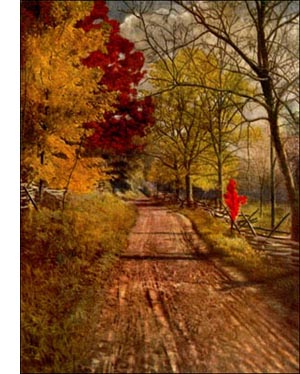Catalpa or Indian Bean Tree
 Catalpa, Indian Bean (Catalpa Catalpa, Karst.)-Low, spreading tree, 25 to 50 feet high, with broad, irregular head of coarse twigs. Bark light brown, reddish, smooth. Wood coarse grained, soft, light brown, durable in contact with the ground.
Catalpa, Indian Bean (Catalpa Catalpa, Karst.)-Low, spreading tree, 25 to 50 feet high, with broad, irregular head of coarse twigs. Bark light brown, reddish, smooth. Wood coarse grained, soft, light brown, durable in contact with the ground. Buds all lateral, above circular leaf scar, minute, globular; inner scales grow to 2 inches long. Leaves bright green, opposite or in three's, 6 to 8 inches long, half as wide, ovate, entire, or sometimes lobed and wavy margined, pubescent beneath; of unpleasant odour; petioles stout, long, terete.
Flowers, June or July, perfect; large, white, irregular, the frilled corolla marked with two yellow stripes and numerous purplish dots; pedicels downy; panicles loose, 6 to 10 inches long. Fruit a green, cylindrical pod, 6 to 20 inches long, 2-valved, filled with flat, tufted seeds.
Preferred habitat, moist, rich soil of river banks or shady woods. Distribution, Georgia and Florida to Mississippi, but naturalised in many other states. Uses: A hardy ornamental tree; wood valuable for inside finish in houses, for posts and railroad ties.
The horse chestnut with its thousand pyramids of bloom is scarcely past its prime when a rival of surpassing loveliness appears. Out of the deadest-looking branches, which show no sign of life until spring has sown meadow and wood with blossoms, a luxuriant crown of bright foliage comes, and with a rush, as if to make up lost time, the tree bursts into bloom.
Now the awkwardness of its frame is forgotten, and the tree looks like a plant from the tropics. The flower clusters are often 10 inches high, loosely conical and blooming from the base upward.
A single flower deserves close scrutiny. The green calyx that enclosed the bud splits in two and the white corolla, with its spreading, scalloped and ruffled border, unfolds. There are five lobes turning out from the deep throat of the flower, where groups and rows of yellow and purple dots adorn the lining.
The bumblebees recognise these markings as an invitation to explore the nectaries of the flower, and the fragrance further reassures them. The two stamens are ripe before the stigma that rises between them. A bee that alights on the broad platform and pushes into the flower's depths for nectar is well brushed with pollen as she passes. This she loses to the sticky stigmas of other blossoms as she pursues her vocation in the honey-laden treetops.
A later comer to that first blossom might note, if she were observant, that the stamens had wilted in the few hours just past, and it is the erect stigma that is brushed with pollen from her hairy body. Thus Nature prevents self-pollination in this species, and sends the unconscious bees to cross-fertilise catalpa flowers.
The pods that hang on the trees in late summer look like long green pencils. The tree is as much a wonder in fruit as in flower. In winter time, the two thin valves split, and out tumbles a multitude of seeds! There is nothing to them -just thin, papery flakes an inch long, fraying at both ends into silvery hairs. The wind scatters them far and near, and the streams float them toward the seas. So the catalpa seeds are spread. The trees have also the habit of sprouting from the stump; and lower branches, lying on the ground, often strike root.